Principles Of Inheritance And Variation Questions And Answers
Question 1. Mention the advantages of selecting a pea plant for the experiment by Mendel.
Answer:
- Annual plant with short life cycle of 2–3 months.
- It has many contrasting traits.
- Pea seeds are large.
- Easy to cultivate.
- Pea plants are naturally self-pollinating.
- Artificial cross-pollination can be easily performed.
Question 2. Differentiate between the following.
- Dominance and Recessive.
- Homozygous and Heterozygous.
- Monohybrid and Dihybrid.
Answer:
1. Dominance and Recessive:
Read and Learn More Class 12 Biology Chapter Wise
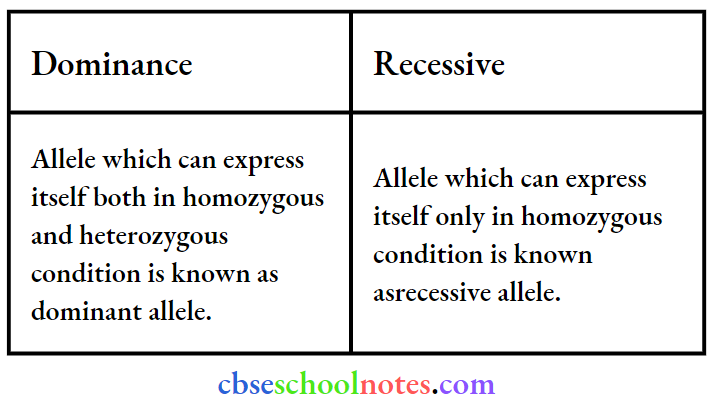
2. Homozygous and Heterozygous:

3. Monohybrid and Dihybrid:
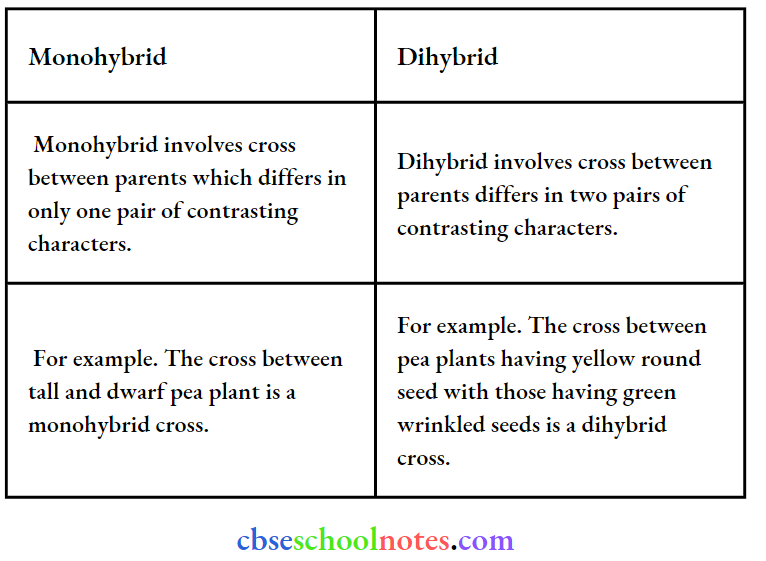
Question 3. A diploid organism is heterozygous for 4 loci, how many types of gametes can be produced?
Answer:
A diploid organism heterozygous for 4 loci, will have four different contrasting characters at four different loci.
For example, if an organism is heterozygous at four loci with four characters, say AaBbCcDd then during meiosis it will segregate to form 16 separate gametes.
Type of gamete = 2“ where n is no of heterozygous pair
Son = 4 so24 so 16 gametes.
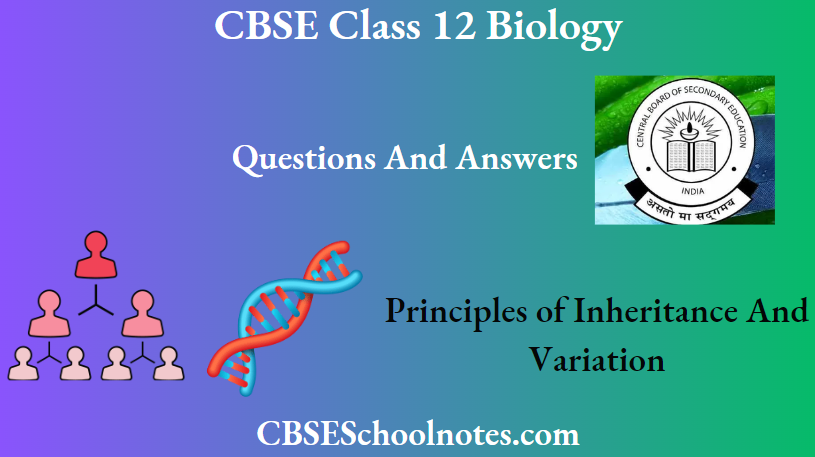
Question 4. Explain the Law of Dominance using a monohybrid cross.
Answer:
When two different factors (genes) or a pair of contrasting forms of a character are present in an organism, only one expresses itself in the Fi generation and is termed dominant while the other remains unexpressed and is called a recessive factor (gene).
Question 5. Define a test-cross.
Answer:
When an individual is crossed with the homozygous recessive parent. It is called test cross
6. Using a Punnett Square, work the distribution of phenotypic features in the first filial generation after a cross between a homozygous female and a heterozygous male for a single
locus.
Answer:
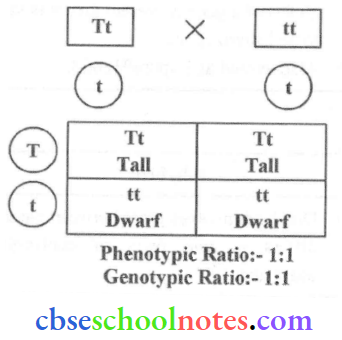
Question 7. When a cross is made between a tall plant with yellow seeds (TtYy) and a tall plant with green seeds (Ttyy), what proportions of phenotype in the offspring could be expected to be Tall and green Dwarf and green.
Answer:
Tall & Yellow Seeds Tall & Green Seeds:

- Tall and green : 3
- Dwarf and green: 1
Question 8. Two heterozygous parents are crossed. If the two loci are linked, what would be the distribution of phenotypic features in Fi generation for a dihybrid cross?
Answer:
The co-existence of two or more genes in the same chromosome is termed as linkage. If the genes are located close to each other and on the same chromosome, they are inherited together and are referred to as linked genes. If two heterozygous parents exhibit linkage, then the outcome is as follows:
BbLl x BbLl
Blue long Blue long
So in the F1 generation, the parental combination will comparatively be more than the newer combinations, which are less in number.
Question 9. Briefly mention the contribution of T.H. Morgan in genetics.
Answer:
Thomas Hunt Morgan is called the father of experimental genetics.
- Experimental verification of the chromosomal theory of inheritance was given by Thomas Hunt Morgan and his colleagues, which led to the discovery of the basis for the variation that sexual reproduction produced.
- Morgan worked with the tiny fruit files, Dr were found very Drosophila melanogaster which were found very suitable for such studies.
- Morgan carried out several dihybrid crosses in Drosophila to study genes that were sex-linked.
- He stated and established that genes are located on the chromosome.
- He established the principle of linkage, crossing over, and sex-linked inheritance and discovered the relationship between genes and chromosomes.
- He established the technique of chromosome mapping.
Question 10. What is pedigree analysis? Suggest how such an analysis, can be useful.
Answer:
A pedigree is a record of inheritance of a specific genetic trait for two or more generations which is presented in the form of a diagram or family tree. Pedigree analysis is an analysis of several generations of a family which is used on human beings.
The usefulness of pedigree analysis:
- Serves as a powerful tool which can be used to trace the inheritance of a particular trait, disease or abnormality
- It is helpful for genetic counsellors to suggest to couple the possibility of having children with genetic abnormalities such as colour blindness, Haemophilia, thalassemia, sickle-cell anaemia etc
- Helpful in reasoning why marriage between close relatives is harmful.
Question 11. How is sex determined in human beings?
Answer:
Sex determination in humans is done by the XX-XY type method. In humans, females have XX chromosomes and males have two different types of sex chromosomes (XY).

Male progeny 50% female progeny – 50%
Question 12. A child has blood group O. If the father has blood group A and the mother’s blood group B, work out the genotypes of the parents and the possible genotypes of the other offspring.
Answer:
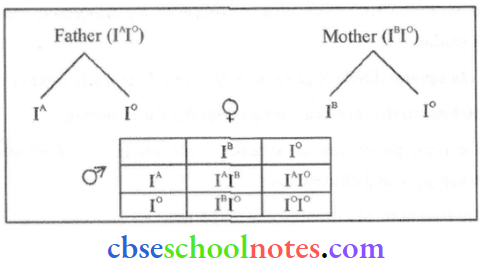
The possible genotype of other offspring – IAIB, IAI°, IB1°, I°I°
Question 13. Explain the following terms with examples.
- Co-dominance
- Incomplete dominance
Answer:
- Co-dominance: In this phenomenon, both the alleles can express themselves independently when found together in a heterozygote. They are termed as co-dominant alleles. E.g., – ABO blood group
- Incomplete dominance: Incomplete dominance may be defined as the partial /expression of both alleles in a heterozygote so that the phenotype is intermediate between those of two homozygotes.
Example:
- Flower colours of Mirabilis jalapa (4 o’clock plant)
- Snapdragon
Question 14. What b point mutation? Give one example.
Answer:
Mutations arising due to changes in a single base pair of DNA are called point mutations.
Example: sickle cell anaemia.
Question 15. Who proposed the chromosomal theory of inheritance?
Answer:
In 1902 the chromosomal theory of inheritance was proposed by Theodore Boveri and Walter Sutton.
Question 16. Mention any two autosomal genetic disorders with their symptoms.
Answer:
Sickle cell anaemia
Symptoms:-
- The shape of RBCs changes from biconcave to sickle-shaped(curved) under the influence of low oxygen tension.
- These sickle-shaped RBCs are more rapidly destructed than the normal ones, causing anaemia Phenylketonuria:-
- This inborn error of metabolism is also inherited as the autosomal recessive trait. The affected individual lacks an enzyme that converts the amino acid phenylalanine into tyrosine. As a result of this phenylalanine is accumulated and converted into phenyl pyruvic acid and other derivatives.
Symptoms:-
- Accumulation of these in the brain results in mental retardation. These are also excreted through urine because of their poor absorption by the kidneys.
